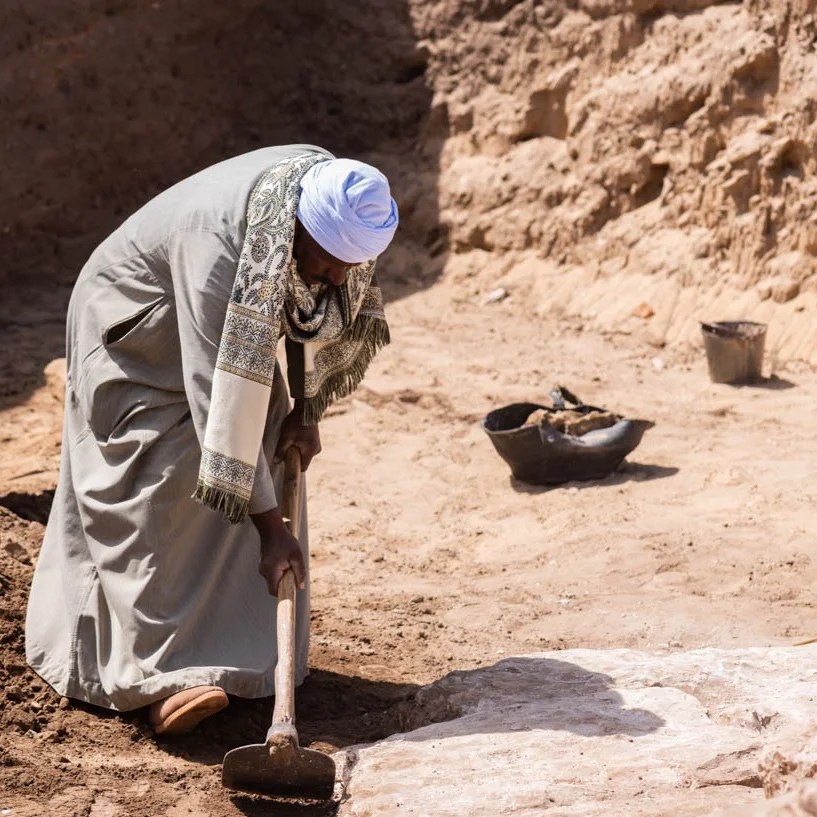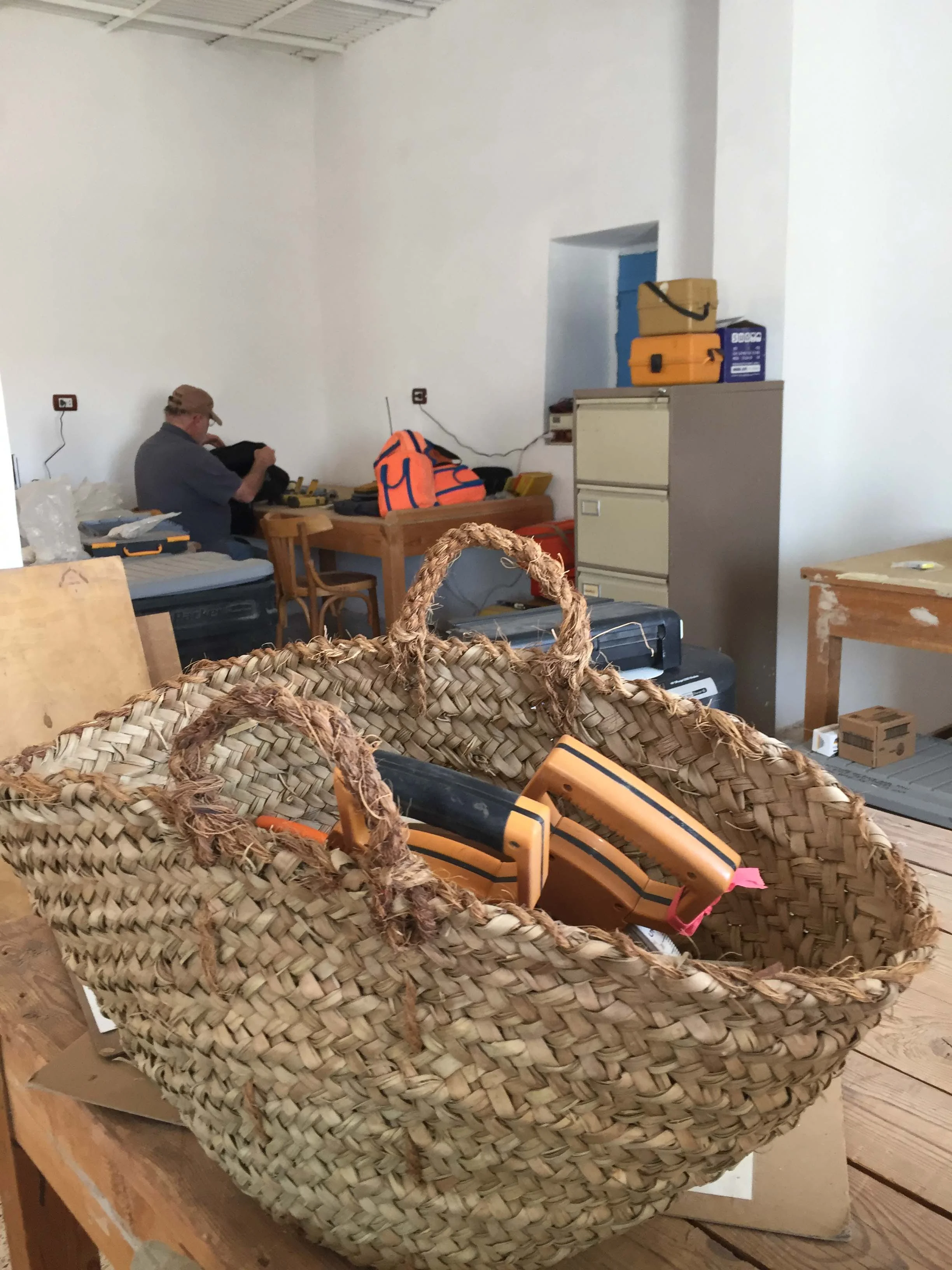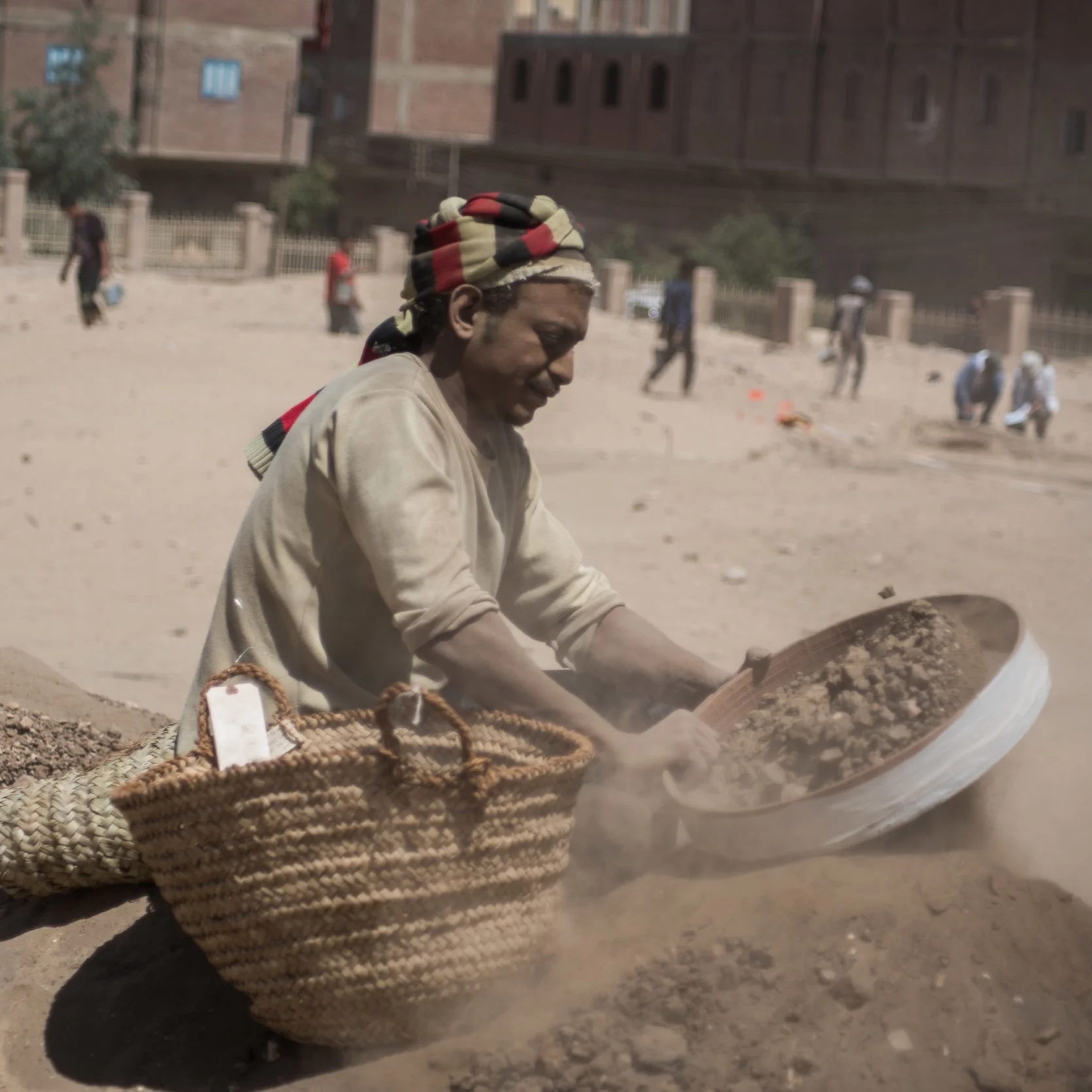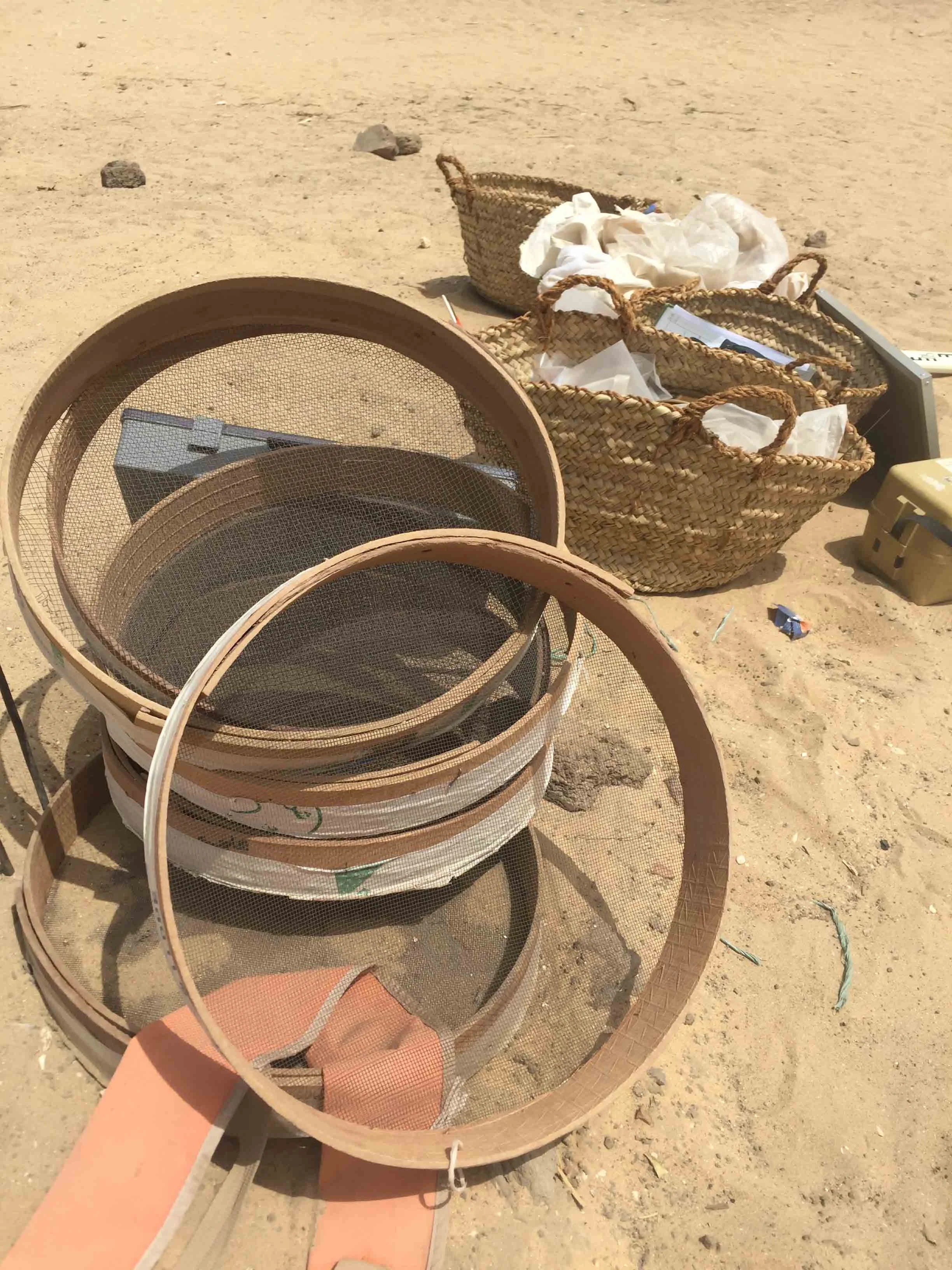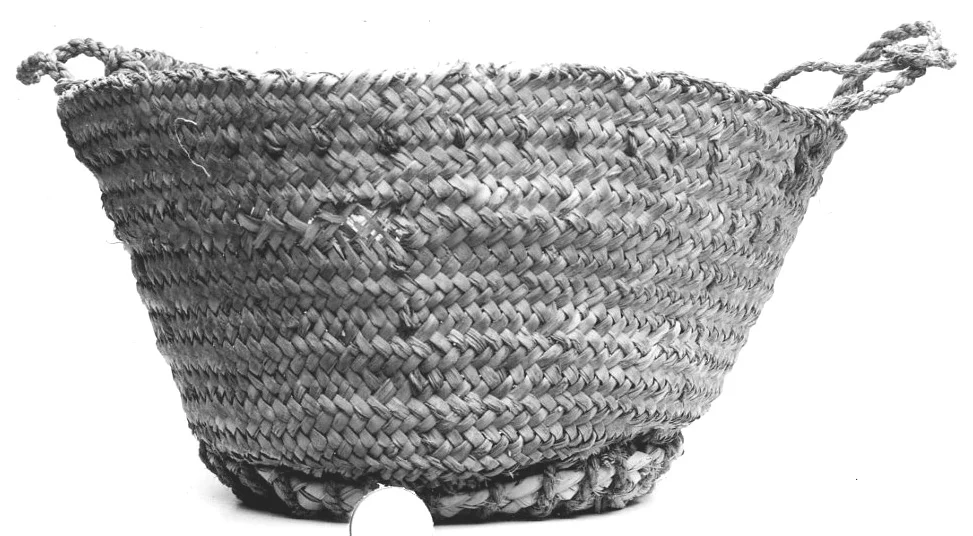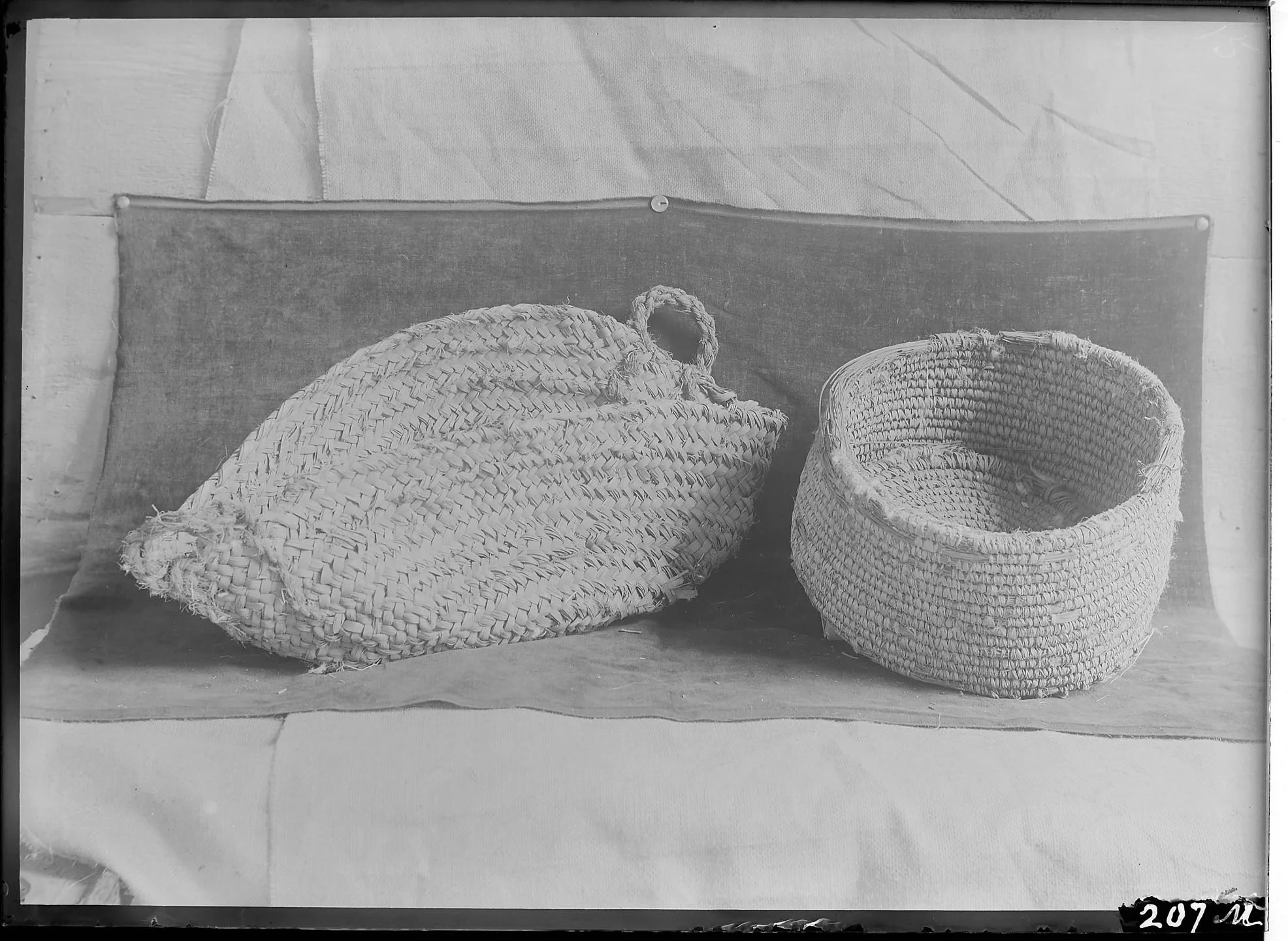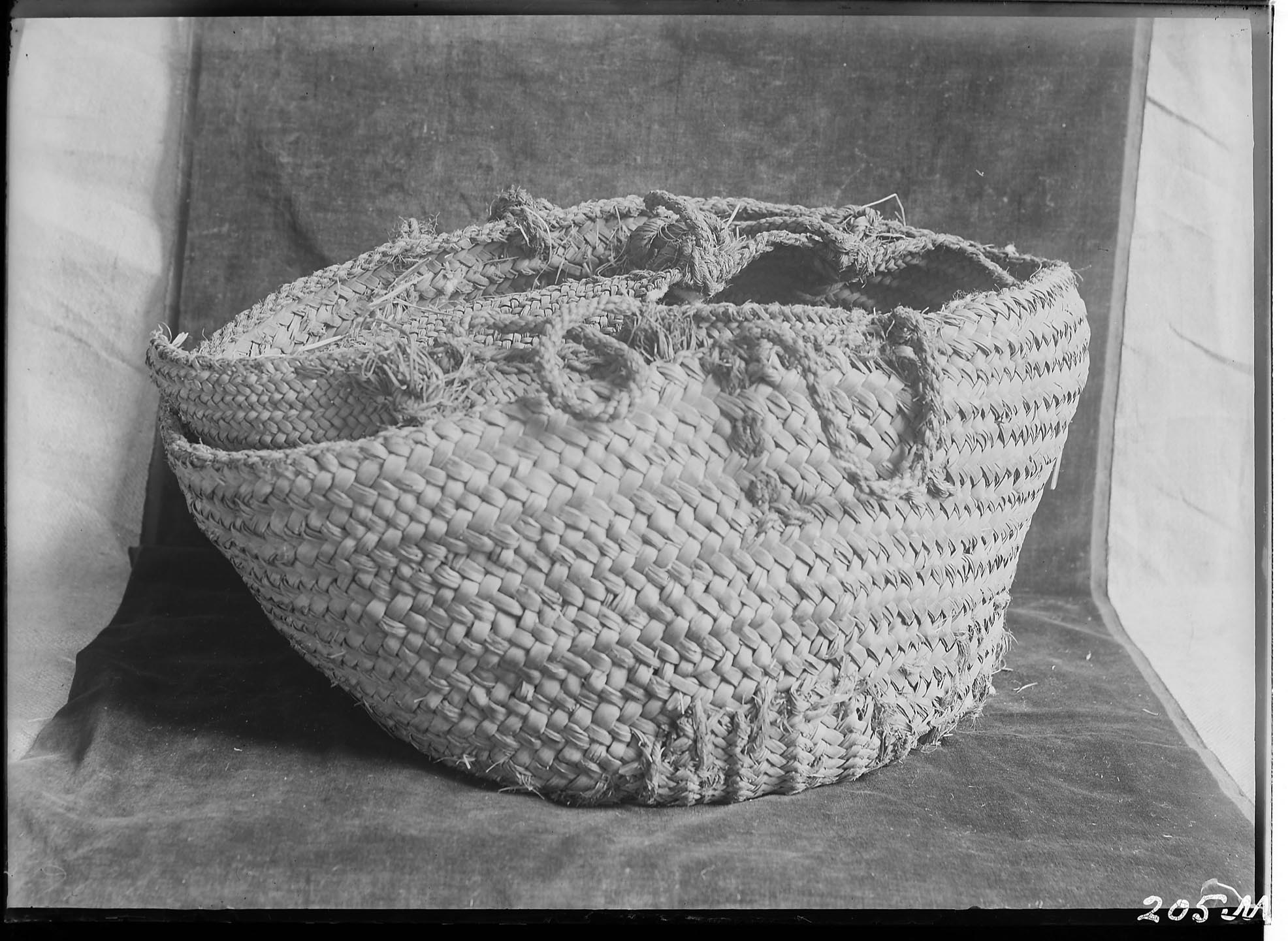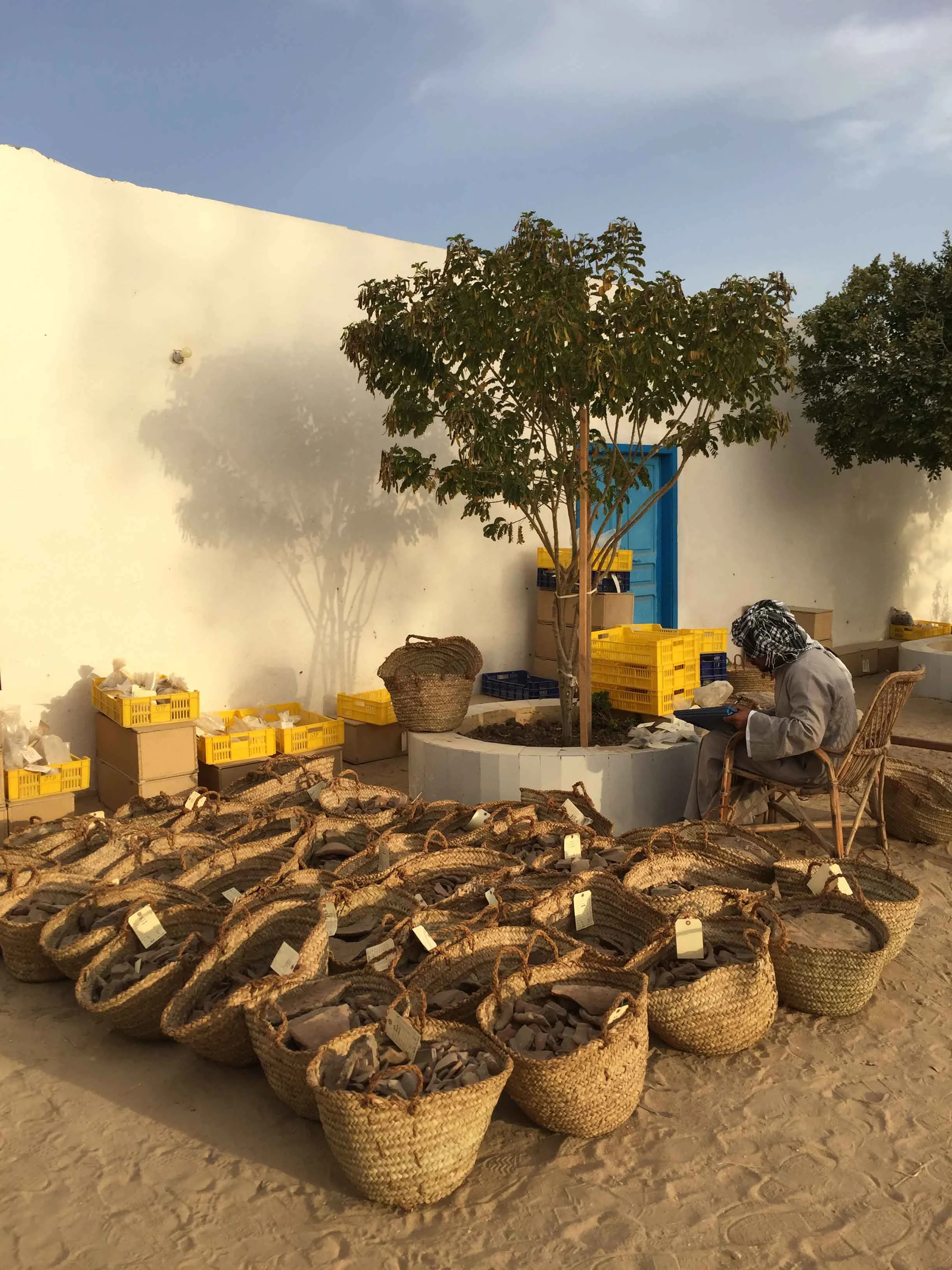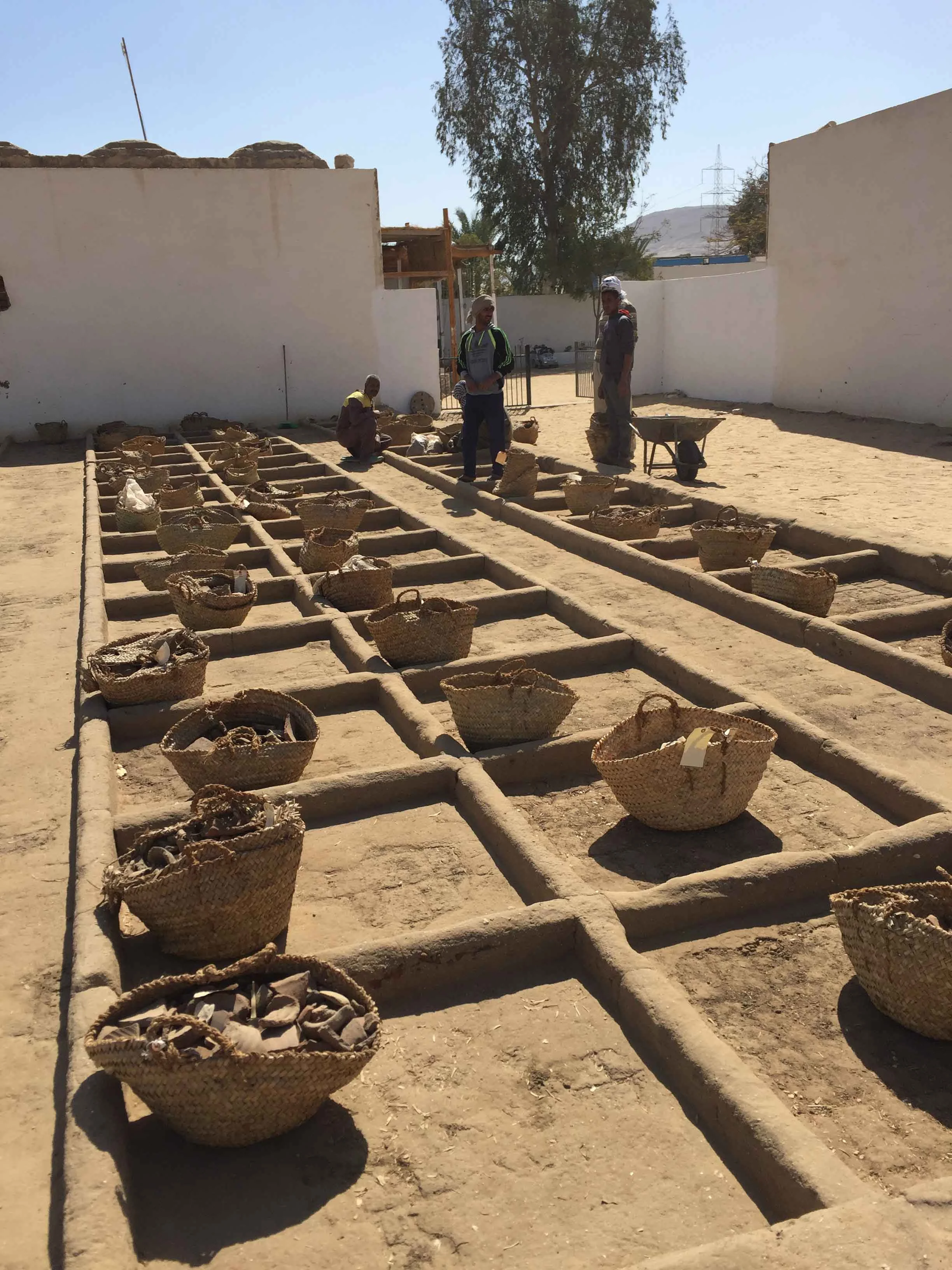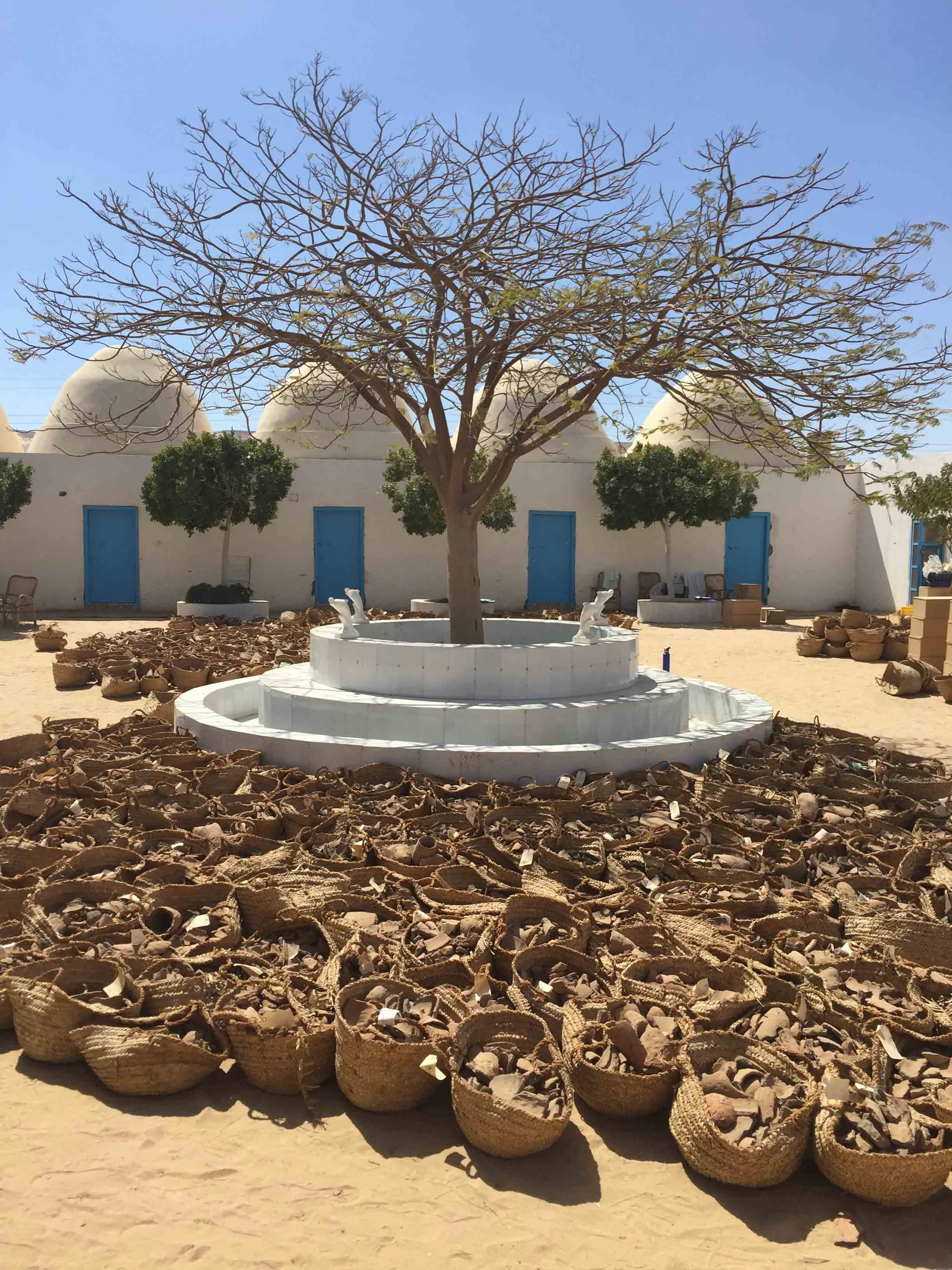Field Diary 2019.4 © Abydos Archaeology
Fig. 1. The tureya, a traditional Egyptian field hoe, is one of the most common and instantly recognizable features of archaeological excavation in Egypt — seen here outside the east corner gateway of the Shunet el-Zebib at Abydos. Photo by Ayman Damarany for North Abydos Expedition © 2019
When you think of archaeology in Egypt, a pyramid, or a trowel, maybe a mummy, or perhaps even a palm tree is probably one of the first things to come to mind. But a hoe and basket? These may bring to mind something closer to life on a farm than an excavation, but did you know there is a long history of adapting traditional agricultural tools to archaeology in Egypt? The طرية (tureya), for example, is a traditional type of Egyptian field hoe that was first adopted as an excavation tool in the early nineteenth century and is still in use in Egyptian archaeology today (Fig. 1). The tureya is ideal as a horizontal scraping tool, which allows for very tight control of how much one is digging, making the trowel only necessary for very fine detail work (Figs. 2,3). The common and instantly recognizable tureya is just one of the tools that highlights the close historical relationship between agricultural and archaeological fieldwork in Egypt. Other, less recognizable examples include the كربال (kirbal, pl. karabil), a traditional type of sieve — which is Egypt’s answer to the fine mesh screens used by archaeologists everywhere to ensure the recovery of even the smallest artifacts — and the مقطف (maqtaf, pl. maqatif), a palm-leaf basket used for gathering, storing, and transporting produce throughout Egypt, which has long been used by archaeologists for collecting dirt, sherds, and other small finds during excavation (Figs. 4,5).
Fig. 2. Ashraf Zeydan Mahmoud — a top archaeological technician from Quft & one of the longest-excavating members of the team at Abydos — uses a tureya to define the edge of a stone block at the Osiris Temple pylon. Photo by Ayman Damarany for North Abydos Expedition © 2019
Fig. 3. Trowel & brush standing by for detail work at the Shunet el-Zebib. Photo by Wendy Doyon for North Abydos Expedition © 2019
Fig. 4. Not only is the maqtaf, a traditional palm-leaf basket, used in the collection and transport of artifacts on site — it is a ubiquitous feature of laboratory life at Abydos, as well. Photo by Wendy Doyon for North Abydos Expedition © 2019
Fig. 5. Traditionally used for sieving grain, the kirbal is Egypt’s answer to the fine mesh screens used by archaeologists everywhere to sift excavation backdirt for small finds. Photo by Ayman Damarany for North Abydos Expedition © 2018
Backdirt
Fig. 6. Like all of the palm-leaf baskets used at Abydos, the karabil are produced locally. Photo by Wendy Doyon / North Abydos Expedition © 2019
At North Abydos, no matter how large or small an excavation from one year to the next, 100% of the material excavated — sometimes up to a thousand cubic meters of dirt at a time — is carefully screened by hand using karabil, which are crafted and sourced locally (Fig. 6). In addition, all pottery sherds or other small objects found during screening make their way into the collections via maqatif, which are also made locally by craftswomen from the nearby village of al-Hagz (Figs. 7,8). The word maqtaf, from the Arabic root for to pick, gather, or harvest, literally means something like “a receptacle for gathering the harvest.” The use of agricultural tools like the tureya and maqtaf was an expedient feature of even the earliest recorded excavations in nineteenth-century Egypt, simply by virtue of the proximity of archaeological sites to cultivation in Egypt, while more specialized tools like the sieve came into use as systematic archaeology was professionalized in the early twentieth century (Fig. 9).
Fig. 7. ‘Ayz al-Din ‘Aisa’s donkey cart loaded with maqatif carrying each day’s small finds, sherds, and excavation gear is one of the most familiar sights of every field season at Abydos. Photo by Wendy Doyon for North Abydos Expedition © 2019
Fig. 8. Outside a basket shop in al-Hagz, a small community midway between al-‘Araba al-Madfuna at Abydos and the larger town of al-Baliana to the east. Photo by Wendy Doyon for North Abydos Expedition © 2019
Fig. 9. By the time British archaeologist T.E. Peet excavated this tomb on the eastern slope of the Middle Cemetery at Abydos in 1910, the kirbal (upper left) — along with the tureya & maqtaf (top) — was already a regular feature of professional excavations, which put the recovery and documentation of all excavated material, including the smallest finds, on a par with museum-worthy objects. Photo courtesy of the Egypt Exploration Society
Fig. 10. Often called the “father of archaeology” for his pioneering field methods and attention to small and fragmentary artifacts, Flinders Petrie — seen here at Abydos in 1899 — was never far from a maqtaf like the one pictured here at his feet (lower left). Photo courtesy of the Petrie Museum of Egyptian Archaeology © UCL
Evidence for the use of palm-leaf baskets to move the huge quantities of dirt excavated from archaeological sites all over Egypt is attested in many early records and publications; the use of baskets made locally in the Abydos region, in particular, can be seen as early as 1899 in photographs of British archaeologist Flinders Petrie’s excavations for the Egypt Exploration Fund during that and subsequent seasons (Figs. 10,11). It was, coincidentally, Petrie’s attention to small finds and their importance to the development of scientific field methods that ensured the continued use of these traditional baskets for the collection and storage of sherds and other fragmentary objects at Abydos, even after modern tools like buckets had replaced the need for palm-leaf baskets in the removal of dirt.
Fig. 11. This image, taken during Petrie’s excavations at Umm al-Qa‘ab in the tomb of King Khasekhemwy — Second Dynasty builder of the Shunet el-Zebib — illustrates two different kinds of palm-leaf basket in use at the time, a shallow type used for moving dirt and sand (at left) and the larger type still in use today (at right). Note the kirbal placed on the wall top at center. Photo courtesy of the Egypt Exploration Society
Digging up Roots in the Field
Fig. 12. Every basket crafted by hand in rural Egypt has its roots in the local soil. Photo by Wendy Doyon for North Abydos Expedition © 2019
This season, archaeological historian Wendy Doyon was privileged to visit basket makers in al-Hagz, a small community located between al-‘Araba al-Madfuna at Abydos and the larger town of al-Baliana to the east, to learn a little bit about the traditional way of making these baskets. Much like the Upper Egyptian town of Qena — about 100km southeast of Abydos — is famous for its pottery, al-Hagz is one of the best-known centers of basket making in the region. However, unlike Qena, it does not enjoy a wide reputation among non-locals. As explained by the proprietors of one workshop in al-Hagz,* the women who make the baskets begin learning the trade as girls, becoming skilled enough over time to produce one basket in just half an hour. From start to finish, the maqatif are made entirely by hand. The process begins by selecting between two kinds of palm fiber, either ابيض (abyad) — the finer “white” fiber that comes from inside the leaf, or اخضر (akhdar) — the cheaper “green” fiber made from the outer part of the leaf (Fig. 12). The green baskets are produced in higher quantities for everyday use, and are also the type used in archaeological excavation, while the white baskets are more expensive and are produced, for example, for the tourist and arts & crafts markets (Fig. 13). The brown, threadlike fibers for use in making the edges and handles of the baskets, as well as the design on decorative pieces, are woven by rolling thin, bark-like strands from the trunk of the palm tree together between the palms of the hand (Figs. 13,14).
Fig. 13. A long, woven band of palm fibers sits uncoiled, ready to be sewn into the shape of a basket — behind it an example of the “white” basket made from the inner part of the palm leaf (upper left) and the cheaper “green” basket made from the outer part of the leaf (upper right). Photo by Wendy Doyon for North Abydos Expedition © 2019
Fig. 14. Baskets that have seen years of action in the desert sun at Abydos are no longer “green” in appearance, but a sun-dried brown that is closer to the color of the basket handles, made from thin strands of plant fiber from the trunk of the palm tree — a bunch of which can be seen between the two finished baskets in the photo at left. Photo by Wendy Doyon for North Abydos Expedition © 2019
The first step in making the basket itself is weaving the palm fibers together by hand. After braiding together a large bunch of cut and pressed palm frond strips — each no bigger than a wisp of tall grass — into long, rolled bands about two inches wide, these woven bands are dried in the sun, then soaked in water for two hours, and finally brushed clean, trimmed, and finished (Fig. 15). Next, thin cords of braided twine, also from the palm leaf, are threaded through thick metal needles, several inches long, and sewn around the inner edge of the woven band as it is coiled upward into the shape of a basket (Figs. 15-17).
Fig. 15. Rolled band of pressed, woven, soaked, and cleaned palm fronds that will become a basket (left) next to a bunch of rough-cut palm fronds (center) used to make the braided twine (right) that serves as thread for sewing the basket together. Photo by Wendy Doyon for North Abydos Expedition © 2019
Fig. 16. Beginning the process of sewing around the inner edge of the woven band with a large metal needle threaded with twine (see photo at left & video below). Photo by Wendy Doyon for North Abydos Expedition © 2019
Fig. 18. Outside a basket & hardware shop on Shari‘a al-Muizz in Cairo, where although it is difficult to tell from a distance, the palm-leaf baskets are of a much cheaper, mass-market quality than their Upper Egyptian counterparts. Photo by Wendy Doyon for North Abydos Expedition © 2019
Even in photographs like those taken at Abydos more than a century ago, the high quality of the baskets crafted in the Abydos region is in clear contrast to the cheaper counterparts found, for example, at markets in Cairo (Fig. 18). It is also interesting to note stylistic parallels between the craftsmanship of modern basket makers from the Abydos region and examples of palm-leaf basketry from ancient Egypt, such as those excavated at Deir el-Bahri by the Metropolitan Museum of Art in 1931, or other examples found in T.E. Peet’s excavations locally (Figs. 19-23). Countless generations of cultural change notwithstanding, perhaps the old adage “if it ain’t broke…” applies nicely here. After all, during any given season, hundreds of these baskets are still central to the collection, transport, sorting, processing, registration, and organization of artifacts at Abydos, including the all-important task of sorting diagnostic pottery sherds, so fundamental to our understanding of the society, culture, and everyday life of ancient Egyptians (Figs. 24-30). In other words, the maqatif are, literally and figuratively, receptacles for gathering the harvest of excavation. Finally, and not least interestingly, the long-standing relationship between archaeologists at Abydos and the basket makers of al-Hagz and the surrounding area wonderfully illustrates the deeply shared historical roots and socio-economic interdependence of modern agricultural and archaeological fieldwork in Upper Egypt.**
—Wendy Doyon, April 30, 2019
Fig. 19. Ancient maqtaf, possibly New Kingdom, excavated at Deir el-Bahri in 1931. Metropolitan Museum of Art 31.3.148
Fig. 21. More ancient baskets found in T.E. Peet’s excavations at Abydos in 1911 — the example on the left bears a striking similarity to the baskets from al-Hagz. Photo courtesy of the Egypt Exploration Society
Fig. 20. Ancient maqatif excavated by T.E. Peet at Abydos in 1911. Photo courtesy of the Egypt Exploration Society
Fig. 22. Second ancient basket of a shallower variety excavated at Deir el-Bahri in 1931. Metropolitan Museum of Art 31.3.147
Fig. 23. This image of Peet’s excavation in progress at Abydos in 1910 captures the tureya and different varieties of maqatif (lower & upper right, left center) in situ. Photo courtesy of the Egypt Exploration Society
Figs. 24-29. Stages of processing pottery at the Abydos field house. Photos by Ayman Damarany, Wendy Doyon, Matthew Adams for North Abydos Expedition © 2018, 2019
Fig. 30. Managing the collection of archaeological material produced by decades of excavation at Abydos is one of the most important aspects of each season’s fieldwork. Here, as in the group of photos above, the huge volume of ancient pottery generated by the excavations over many years is being processed by specialists from Quft, who carefully identify diagnostic pieces — such as rims, bases, handles, and pieces with distinctive decoration or inscriptions — to be housed in the on-site collections for future detailed study. An equally huge volume of baskets from al-Hagz is central to collections management at the Abydos field house, which incidentally boasts one of the greatest sherd yards ever built in the field! Photo by Matthew Adams for North Abydos Expedition © 2018
Notes
*The basket makers at this shop requested not to be identified on the Internet or social media.
**The broader themes of this post are the subject of the author’s forthcoming dissertation at the University of Pennsylvania; see, for example, Wendy Doyon, “The History of Archaeology through the Eyes of Egyptians” in Unmasking Ideology in Imperial and Colonial Archaeology, edited by Bonnie Effros and Guolong Lai, pp.173-200, Cotsen Institute of Archaeology Press, 2018.


